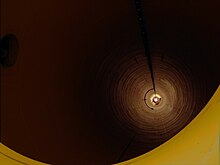Drop tube
In physics and materials science, a drop tower or drop tube is a structure used to produce a controlled period of weightlessness for an object under study. Air bags, polystyrene pellets, and magnetic or mechanical brakes are sometimes used to arrest the fall of the experimental payload. In other cases, high-speed impact with a substrate at the bottom of the tower is an intentional part of the experimental protocol.
Typical operation


For a typical materials science experiment, a sample of the material under study is loaded into the top of the drop tube, which is backfilled with inert gas or evacuated to create a low-pressure environment. Following any desired preprocessing (e.g. induction heating to melt a metal alloy), the sample is released to fall to the bottom of the tube. During its flight or upon impact the sample can be characterized with instruments such as cameras and pyrometers.
Drop towers are also commonly used in combustion research. For this work, oxygen must be present and the payload may be enclosed in a drag shield to isolate it from high-speed "wind" as the apparatus accelerates toward the bottom of the tower. See a video of a microgravity combustion experiment in the NASA Glenn 5 s drop facility at [1].
Fluid physics experiments and development and testing of space-based hardware can also be conducted using a drop tower. Sometimes, the ground-based research performed with a drop tower serves as a prelude to more ambitious, in-flight investigation; much longer periods of weightlessness can be achieved with parabolic-flight-path aircraft or with space-based laboratories aboard the Space Shuttle or the International Space Station.
The duration of free-fall produced in a drop tube depends on the length of the tube and its degree of internal evacuation. The 105-meter drop tube at Marshall Space Flight Center produces 4.6 seconds of weightlessness when it is fully evacuated. In the drop facility Fallturm Bremen University of Bremen in Bremen, a catapult can be used to throw the experiment upwards to prolong the weightlessness from 4.74 to nearly 10 seconds. Neglecting the physical space needed for the initial acceleration, this technique doubles the effective period of weightlessness. The NASA Glenn Research Center has a 5 second drop tower (The Zero Gravity Facility) and a 2.2 second drop tower (The 2.2 Second Drop Tower).
Much of the operating cost of a drop tower is due to the need for evacuation of the drop tube, to eliminate the effect of aerodynamic drag. This may be avoided by dropping the experiment placed inside an outer box (the drag shield) in such a way that the experiment can fall relative to the outer box.
Historical uses
Though the story may be apocryphal, Galileo is popularly thought to have used the Leaning Tower of Pisa as a drop tower to demonstrate that falling bodies accelerate at the same constant rate regardless of their mass.
Drop towers called shot towers were once useful for making lead shot. A short period of weightlessness allows molten lead to solidify into a perfect sphere by the time it reaches the floor of the tower.
List of drop towers
- NASA Glenn Research Center 2.2 Second Drop Tower
- NASA Glenn Research Center Zero-G Research Facility
- Micro-Gravity Laboratory of Japan (MGLAB)
- Fallturm Bremen
- NASA Marshall Space Flight Center Drop Tube Facility
- Experimental drop tube of the metallurgy department of Grenoble
